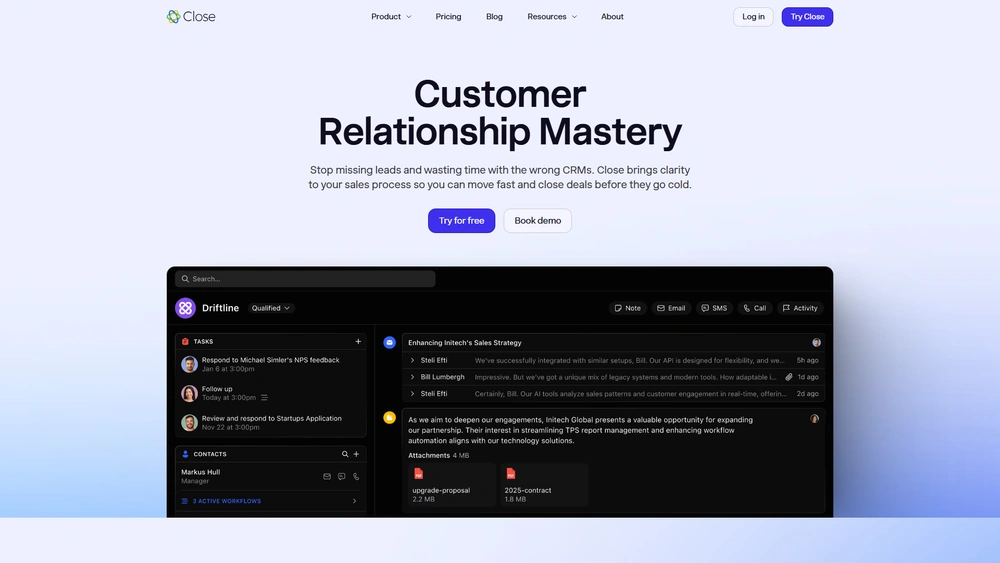Close Overview & 2025 Industry Position
Close is a modern, sales-first CRM built to empower revenue teams with tools purposefully designed for inside sales, B2B outreach, and fast-moving startups. Since its launch, it has become a standout option for small and midsize teams seeking a CRM that emphasizes speed, minimal data entry, high-quality automation, and efficient pipelines. In 2025, Close differentiates itself with a smart navigation structure, workflow-centric UX, and features that allow teams to turn sales conversations into actionable revenue faster than traditional CRM systems.
From Launch to 2025: Close’s Journey
Close originated in 2013 as an internal tool at Elastic (ElasticSales), built by Steli Efti’s team to streamline outbound sales. Seeing market demand, the founders spun it off into a standalone CRM built for fast-moving sales orgs that preferred simplicity over bloated features. Key development milestones include:
- 2013: Close launches publicly as a lightweight, all-in-one CRM tool for outbound sales teams.
- 2015: Enhanced with built-in calling and email sequences for follow-ups.
- 2019: Adds predictive dialer and multichannel automation features.
- 2022: Advanced Zoom and Zapier integrations expand ecosystem possibilities.
- 2024: Smart Views and opportunity pipelines updated with modern analytics and auto-save logic.
- 2025: Focuses on simplifying hybrid sales workflows and deepening integrations with RevOps tools.
In 2025, Close is strategically positioned to serve lean sales teams that want results without overwhelming complexity.

Close Key Features
Close’s core features are geared toward accelerating workflows for outbound-focused teams. Notable highlights include:
- Built-in calling: Native VoIP with call recording, auto-logging, and predictive dialer support.
- Email automation: Templates, sequences, delivery tracking, and smart follow-ups.
- Smart Views: Custom dynamic lead filters to segment workflows by rep, stage, priority, or behavior.
- Power Dialer: Prioritized calling queue with call recordings, scripts, and built-in time zone logic.
- CRM + Inbox: Merge customer communication (email, phone, SMS) into one streamlined timeline.
- Opportunity tracking: Kanban-style pipeline with full audit trail and forecasting modules.
Workflow & UX
Close offers one of the most intuitive user experiences among sales CRMs. Its functional layout strips out CRM noise and replaces it with high-efficiency workflows. Navigation never feels bloated and users can move from lead to activity to report within two to three clicks.
Highlights include:
- Keyboard shortcuts for nearly every primary action (e.g., creating emails, task views, switching pipelines).
- Activity feed and next tasks visible in-context without switching tabs.
- “Inbox Zero” logic applied to leads — nothing is out of view or hidden in menus.
Close Pricing Analysis & Value Metrics
| Plan | Monthly (Billed Annually) | Includes |
|---|---|---|
| Startup | $39/user | Basic CRM, calling, email sync, pipeline |
| Professional | $69/user | Power Dialer, workflows, custom activities |
| Enterprise | $99/user | Sales forecasting, advanced permissions, API access |
Value verdict: Close is competitively priced for fast-growing sales teams looking to replace bloated traditional CRMs. The Professional plan offers optimal ROI for outbound functions, sequences, and personalization workflows.
Competitive Landscape
| CRM | Best For | Key Difference |
|---|---|---|
| Close | Outbound sales teams | Built-in dialer, simplified UX |
| HubSpot CRM | Marketing + sales orgs | Robust marketing platform |
| Pipedrive | Simplified pipeline users | Strong visuals, weaker calling |
| Salesforce Essentials | Enterprise-driven orgs | Deep customization, heavy learning curve |
Close stands out for small teams who value speed and are calling heavy. Unlike platforms pushing feature sprawl, it stays lean and practical.
Use Cases
Close thrives in sectors where rapid-response communication and aggressive outbound strategies drive success. Examples include:
- B2B SaaS sales teams with SDR + AE combo reps
- Real estate and brokerage firms using phone outreach
- Cohorted education and coaching teams
- Agencies managing multiple clients or lists
Its power users often include founders, RevOps, or sales leaders who are hands-on with their stack.
Integrations That Matter
With dozens of direct and Zapier-based integrations—Close helps centralize your workflow, not clutter it:
- Zoom: One-click meeting scheduling
- Gmail/Outlook: Email sync and tracking
- Zapier: 5,000+ automation possibilities
- Slack: Deal alerts and notes via channels
- Stripe + QuickBooks: Customer AR overlays
Pros & Cons of Using Close
- Pros:
- Lightning-fast UX with practical design
- Built-in sales dialer saves cost and complexity
- Great mobile experience for SDRs
- Transparent pricing with strong mid-tier option
- Integrated communication history per contact
- Cons:
- No native marketing automation tools
- Lacks full-fledged mobile pipeline editing
- Smaller support team than Salesforce or HubSpot
Final Thoughts
Close is an ideal CRM for small to medium sales teams who rely on momentum and efficiency. It removes friction from managing leads and workflows while keeping the focus on follow-ups and conversations that convert. If you’re a founder-led sales team or a scaling SDR crew with little time for CRM setup drama, this might be your best tool in 2025.
Pro Tip: Use Close’s Smart Views to group your leads into high-intent buckets. It’s like having an SDR co-pilot triage your tasks every morning.
Close Q & A
Yes, Close has a built-in Power Dialer and Predictive Dialer available in the Professional plan and up.
Absolutely. Close is built for lean outbound teams who need fast execution and easy collaboration.
Yes. You can send bulk and sequenced emails using custom templates, with open/reply tracking included.
Yes, Close supports Slack integrations for activity alerts, notes, and lead status changes.
While optimized for outbound flows, Close supports inbound lead handling via integrations and Smart Views.